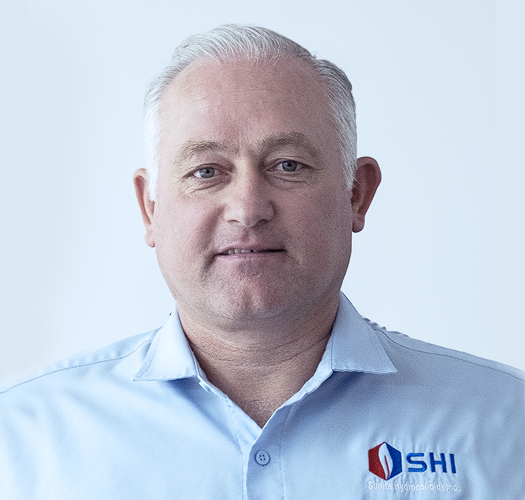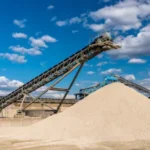Choosing the Right Crosslinker for Your Oilfield Operations: Key Factors to Consider

Hydraulic fracturing depends on fluid performance and for crosslinked gels, crosslinkers are the chemical additives that ensure it. These agents control viscosity, improve proppant transport and directly impact well stimulation outcomes. Thus, engineers and buyers need to consider their role when selecting fluid systems.
This post breaks down what crosslinkers do, how they interact with guar-based polymers and why choosing the right type matters for operational efficiency and cost control.
What is a Crosslinker?
A crosslinker is a chemical additive used in hydraulic fracturing fluids to boost viscosity and fluid strength. It reacts with guar-based gels or derivatized polymers to form chemical bridges between polymer chains, creating a three-dimensional gel network.
They interact with specific functional groups on each molecule, resulting in covalent bonds that stabilize the gel network. This gel structure improves thermal stability and enhances proppant transport deep into the fracture.
By helping maintain fracture width and keeping pathways open, crosslinkers play a direct role in supporting hydrocarbon flow. Sunita Hydrocolloids offers field-proven crosslinkers built for high-performance oilfield operations.
Why Crosslinkers Matter in Hydraulic Fracturing
No two reservoirs are identical. Temperature, salinity and formation pressure vary widely, making a one-size-fits-all fluid system unreliable. Crosslinkers give operators the control they need to match fluid performance to field conditions.
Key benefits of crosslinkers:
- Enhanced Viscosity: They keep proppants suspended and moving deep into the fracture.
- Thermal Stability: They maintain gel strength in high-temperature zones.
- Improved Fluid Efficiency: They reduce fluid loss and improve coverage across the zone.
- Controlled Breakability: They work with breakers for clean, efficient post-job recovery.
Optimized crosslinked fluids can boost treatment conductivity by a significant percentage. Sunita Hydrocolloids delivers crosslinkers engineered for high-performance U.S. oilfield stimulation.
Types of Crosslinking Agents
Choosing the right crosslinker starts with understanding how each type behaves under field conditions. Temperature, pH, polymer type and job duration all influence performance.
These crosslinking reagents are selected based on their chemical properties and compatibility with specific field conditions. Here’s a breakdown of the most common crosslinking agents used in hydraulic fracturing fluids.
1. Borate Crosslinkers
Borate crosslinkers are widely used in North American shale plays for low to medium-temperature wells. They activate quickly in fluids with a pH above 9.5 and form reversible bonds with guar-based polymers.
This fast hydration makes them ideal for rapid deployment in modern fracturing applications. Their reversibility also supports efficient post-job cleanup when paired with compatible breakers.
2. Zirconate Crosslinkers
Zirconate crosslinkers are built for high temperature formations above 275°F. They form strong, irreversible bonds that delay viscosity development, allowing deeper penetration before gel strength peaks.
These agents are preferred in thermally demanding wells where fluid stability and shear resistance are critical. Sunita Hydrocolloids offers zirconate formulations optimized for CMHPG-based systems.
3. Titanate Crosslinkers
Titanium based crosslinkers are engineered for extreme downhole conditions exceeding 300°F. They deliver high gel strength, long pumping windows and exceptional thermal stability.
These are often deployed in deep unconventional wells where extended fluid life and consistent proppant transport are non-negotiable.
4. Aluminum and Iron Crosslinkers
Used less frequently, aluminum and iron crosslinkers serve niche applications or cost sensitive operations. They exhibit unique crosslinking behavior and may require tighter control of water chemistry and pH. Environmental sensitivity and compatibility with formation minerals must be evaluated before use.
Key Factors to Consider When Selecting a Crosslinker
Choosing the right crosslinker is not just about chemistry; it’s about matching fluid behavior to the realities of your reservoir. From temperature extremes to regulatory pressure, each factor plays a role in how your fracturing job performs. Crosslinkers can be engineered with different combinations of reactive groups to optimize performance for specific reservoir conditions.
Here’s what U.S. engineers and buyers should weigh before selecting a crosslinking agent.
1. Reservoir Temperature
High temperature wells demand thermally stable crosslinkers like zirconate and titanate. These agents maintain gel integrity above 275°F and resist thermal thinning. For cooler zones, borate crosslinkers offer fast activation and reversible bonding, ideal for rapid treatments.
2. Water Chemistry and pH
Borate crosslinkers require a pH above 9.5 to activate properly. If your water source contains high levels of calcium or magnesium, it may interfere with buffer systems. Zirconate and chromium based agents are more tolerant of variable water chemistry and salinity.
3. Shear Sensitivity and Pumping Conditions
High shear environments can degrade gel structure prematurely. Delayed crosslinkers or dual action systems help maintain viscosity during aggressive pumping. Sunita Hydrocolloids offers formulations that recover viscosity post shear, ensuring consistent proppant transport.
4. Desired Gel Break Profile
Crosslinkers must work in sync with breakers to ensure clean flowback. Fast breaking gels reduce formation damage and improve post job productivity. Compatibility with oxidizers or enzyme based breakers is essential.
5. Formation Sensitivity
Some formations react poorly to metal ions, causing fines migration or permeability loss. Choose crosslinkers tested for minimal formation damage and validated through lab and field trials.
6. Environmental and Regulatory Compliance
U.S. regulations demand low toxicity, low VOC chemical systems. Sunita’s eco advanced crosslinkers meet these standards without sacrificing performance, supporting ESG goals and operational safety.
Smart selection leads to better conductivity, cleaner wells and fewer surprises downhole.
Role of Crosslinkers in Proppant Transport and Fracture Conductivity
Crosslinked gels outperform linear fluids by delivering higher viscosity and elasticity, which are critical for suspending and transporting proppants deep into the fracture. This helps maintain wider fracture openings and ensures long term conductivity under closure stress.
Optimized crosslinker systems significantly enhance proppant placement and fracture conductivity, directly improving oil and gas recovery. Sunita Hydrocolloids’ field proven crosslinkers are engineered to support consistent proppant delivery and sustained hydrocarbon flow in demanding U.S. reservoirs.
Common Misconceptions About Crosslinkers
- “More viscosity is always better” – Over-crosslinking can lead to excessive gel strength, high friction, poor breakability and reduced fracture conductivity.
- “Crosslinkers are interchangeable” – Each crosslinker is designed for a specific temperature, pH and polymer system. Swapping them without testing risks job failure.
- “Only borate systems are used” – Zirconate and titanate crosslinkers are now widely used in deeper, hotter wells for their thermal resilience.
Application Trends in the U.S. Oilfield Market
Longer laterals, bigger stages and harsher downhole conditions are reshaping completion designs across U.S. unconventional plays. Hybrid fluid strategies, starting with slickwater and transitioning to crosslinked gels, are now standard in the Permian, Eagle Ford and Bakken.
Operators often switch between linear and crosslinked gels based on stage geometry, proppant concentration and reservoir depth. Sunita Hydrocolloids delivers crosslinkers built for this evolving field strategy.
Crosslinkers Offered by Sunita Hydrocolloids
Sunita Hydrocolloids delivers high-performance crosslinkers engineered for hydraulic fracturing and well completion. Their formulations are carefully balanced to ensure optimal interaction between all components of the fracturing fluid system.
Their formulations are compatible with guar and derivatized polymer systems, offering thermal stability, clean break profiles and minimal residue. Whether for moderate or ultra high-temperature wells, Sunita’s crosslinkers are built for consistent field performance and optimized proppant transport..
Final Thoughts
Matching crosslinkers to reservoir conditions is not just chemistry; it’s strategy. The right choice drives fluid performance, supports regulatory alignment and protects field economics. Whether you’re working with high temperature formations or complex polymer systems, precision matters.
Sunita Hydrocolloids delivers U.S. market-ready crosslinkers built for reliability and operational impact. Contact us to know more about Sunita’s crosslinker technologies for tailored completions.





